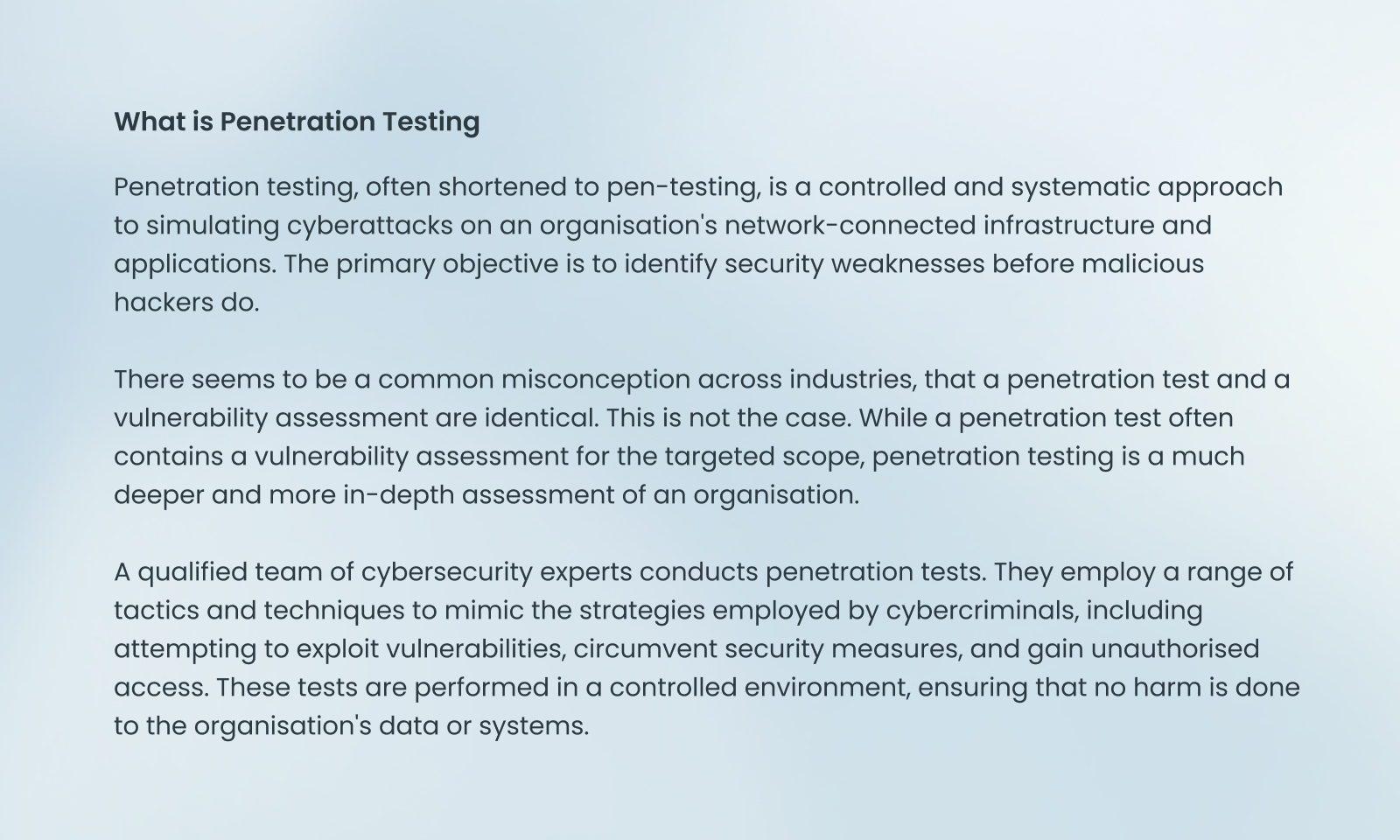In today’s hyper-connected digital landscape, where data is the lifeblood of organisations, and cyber threats loom like dark clouds on the horizon, the need for cyber protection is as vital as ever. Cyber threats constantly evolve, becoming more sophisticated and elusive, leaving organisations vulnerable to potentially devastating breaches. This is where penetration testing, often referred to as ethical hacking, steps in as a powerful tool to defend against these threats.
The Cybersecurity Landscape
As technology advances at an unprecedented pace, so do the capabilities of cybercriminals. They are no longer limited to the stereotypical lone hacker in a basement; they are well-organized, financially motivated entities with access to cutting-edge tools and techniques. From nation-state actors to criminal syndicates, the range and scope of cyber threats are broad and constantly evolving with a complete disregard of laws and ethical scruples.
In this ever-shifting landscape, it’s not a matter of ‘if’ but ‘when’ a cyberattack will occur. Organisations must proactively identify their systems’ vulnerabilities before malicious actors exploit them. This is precisely where penetration testing plays a pivotal role.

The Benefits of Penetration Testing
A well-executed penetration test doesn’t just shore up essential technical defences, but cultivates a vast amount of advantages, paving the way for a more secure and future-ready business environment. The list of advantages includes,
- Identifying Vulnerabilities: Penetration testing helps businesses identify weaknesses and vulnerabilities in their systems, networks, and applications. This proactive approach allows them to discover and address security issues before malicious hackers can exploit them.
- Risk Mitigation: By locating and addressing vulnerabilities, penetration testing reduces the risk of security breaches and data leaks. This, in turn, minimises the potential financial and reputational damage that can result from such incidents.
- Compliance and Regulatory Requirements: Many industries and sectors have specific cybersecurity regulations and compliance requirements beyond the national and regional requirements (NIS2 within the European Union , ISO/IEC 27001, DORA etc.). Penetration testing can help businesses meet these requirements and avoid non-compliance penalties.)
- Enhancing Security Measures: Penetration testing provides valuable insights into the effectiveness of existing security measures. Organisations can then fine-tune their security strategies, ensuring that investments in cybersecurity are allocated wisely and that security controls are optimized.
- Business Continuity: Cyberattacks can disrupt operations, leading to downtime and financial losses. Penetration testing helps organisations identify potential points of failure and develop strategies to maintain business continuity in the event of a security incident.
- Protection of Customer and Employee Data: Businesses store sensitive customer and employee data, and data breaches can have severe consequences. Penetration testing helps ensure this data remains secure, maintaining trust among stakeholders.
- Competitive Advantage: Demonstrating a commitment to cybersecurity through regular penetration testing can be a competitive advantage. Clients and partners are more likely to trust your organisation if you take your security and the safeguarding of data serious.
- Preventing Reputation Damage: A security breach can tarnish a company’s reputation, losing customers and partners. Penetration testing helps prevent such incidents, protecting the organisation’s reputation and image.
- Cost Savings: Detecting and addressing vulnerabilities through penetration testing is generally more cost-effective than dealing with the aftermath of a data breach. The financial impact of breaches includes legal fees, regulatory fines, remediation costs, and potential lawsuits.
- Continuous Improvement: Cyber threats are continually evolving, so cybersecurity measures must also evolve. Regular penetration testing ensures that security measures remain up-to-date and effective against new and emerging threats.
- Prioritisation of Remediation: Penetration testing provides organisations with a clear picture of which vulnerabilities pose the most significant risks. This helps businesses prioritise remediation efforts and allocate resources more effectively.
- Peace of Mind: Knowing that a thorough penetration test has been conducted and vulnerabilities have been addressed can provide peace of mind to business leaders, allowing them to focus on their core operations without the constant worry of cyber threats.

The Evolving Role of Penetration Testing
As the threat landscape continues to evolve, so does the role of penetration testing. It’s no longer just a box-ticking exercise to meet compliance requirements. Instead, it has become a dynamic and ongoing process that adapts to the changing tactics of cybercriminals.
Today, organisations are adopting a continuous testing approach, integrating penetration testing into their regular cybersecurity practices. This ensures that as new vulnerabilities emerge, they are quickly identified and remediated in a continuous improvement cycle. In addition to the benefits of continuous penetration testing, organizations can also gain significant advantages by blending offensive and defensive approaches.
Offensive penetration testing simulates real-world attacks to identify vulnerabilities that could be exploited by adversaries. This type of testing can be used to assess the security of networks, applications, cloud infrastructure, and other IT assets.
Defensive penetration testing assesses the effectiveness of security controls and identifies areas where improvement is needed. This type of testing can be used to evaluate firewalls, intrusion detection systems, access control lists, and other security technologies.
By blending offensive and defensive penetration testing, organizations can get a more complete picture of their security posture and identify vulnerabilities that might otherwise be missed. This information can then be used to prioritize remediation efforts and improve overall security. This approach enables organizations to identify and fix security vulnerabilities before they can be exploited by attackers. By integrating penetration testing into their regular cybersecurity practices, organizations can stay ahead of the curve and protect their assets from the latest threats.
Moreover, penetration testing has expanded beyond traditional network and application assessments. It now encompasses a wide range of areas, including cloud security, IoT devices, and even social engineering testing to evaluate the human element of security. In addition to these specific areas, penetration testing can also be used to assess the security of other IT assets, such as databases, operating systems, and mobile devices.
There are several benefits to expanding penetration testing beyond traditional network and application assessments. First, it allows organizations to identify and mitigate vulnerabilities in a wider range of IT assets. This is important as attackers are constantly developing new methods of attack, and they are increasingly targeting non-traditional assets, such as cloud environments and IoT devices.
Anders Fleinert Larsen, VP Trifork Cyber Protection“Blending offensive and defensive penetration testing is like having both a shield and a sword. It allows you to identify and mitigate vulnerabilities, while also understanding how an attacker might exploit them. This comprehensive approach is essential for building a truly secure organization”.
Trifork Cyber Protection’s Proven Approach
Recognising the necessity of proactive measures, Trifork Cyber Protection are embracing innovative methodologies such as the fresh approach to security testing, which places an ethical attacker within the defined scope’s confines, assuming the identity of an authorised user. This paradigm shift seeks to replicate the circumstances of a compromised system/scope or an untrustworthy insider, delving beyond conventional black-box penetration test assessments.
Trifork Cyber Protection’s penetration testing approach transcends mere technical prowess; it embodies a holistic perspective that pivots toward comprehending the broader implications of business risk. Central to its objectives is a meticulous examination of insecurities, vulnerabilities, and misconfigurations that can potentially undermine organisations’ critical data and operational workflows. Rather than fixating solely on technical triumphs or attaining initial access through laborious means, the emphasis is firmly planted on discerning how these vulnerabilities interplay with genuine business risks. In doing so, this approach not only offers a deeper understanding of the organisation’s security posture, explicitly focusing on the defined scope but also identifies avenues for targeted enhancements that align with the overarching objectives of the business.
As we embark on the journey of dissecting the findings of the pen-tests, it is imperative to recognise that Trifork Cyber Protection does not merely enumerate technical minutiae. Instead, we serve our findings as a roadmap for translating technical insights into actionable strategies that safeguard critical assets, ensure operational continuity, and fortify organisations against the inevitable challenges posed by a dynamic threat landscape.
Conclusion
In an era where the digital, interconnected realm is as vital as the physical, penetration testing emerges as a beacon of hope in the battle against cyber threats. Trifork Cyber Protection empowers organisations to stay one step ahead of cybercriminals, identify vulnerabilities, and fortify their defences through a proven approach. It’s not merely a security measure; it’s a strategic imperative.
By embracing penetration testing through Trifork Cyber Protection as an ongoing practice, our customers safeguard their digital assets, protect their reputation, and ensure a secure and resilient future in an increasingly digital world. Ultimately, Trifork Cyber Protection’s approach extends beyond technology; it revolves around security & the protection of your digital assets, assurance and trust, which are the foundational pillars of the digital era.
For further information please contact:

Latest articles & Updates
